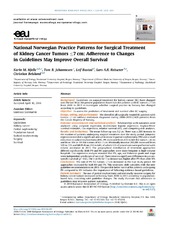| dc.description.abstract | Background: Guidelines on surgical treatment for kidney cancer (KC) have changed over the last 10 yr. We present population-based data for patients with KC tumors ≤7 cm from 2008 to 2013 to investigate whether surgical practice in Norway has changed according to guidelines. Objective: To assess the predictors of treatment and survival after KC surgery. Design, setting, and participants: We identified all surgically treated KC patients with tumors ≤7 cm without metastasis diagnosed during 2008–2013 (2420 patients) from the Cancer Registry of Norway. Outcome measurements and statistical analysis: Relationships with outcomes were analyzed using joinpoint regression, multivariate logistic regression, Kaplan-Meier survival estimates, Cox regression, relative survival (RS), and competing-risk analyses. Results and limitations: The mean follow-up was 5.2 yr. There was a 28% increase in the number of patients undergoing surgical treatment over the study period. Joinpoint regression revealed a significant annual increase in partial nephrectomy (PN) and a small reduction in radical nephrectomy (RN). PN increased from 43% to 66% for tumors ≤4 cm and from 10% to 18% for tumors of 4.1–7 cm. Minimally invasive (MI) RN increased from 53% to 72% and MI PN from 25% to 64%, of which 55% of procedures were performed with robotic assistance in 2013. The geographical distribution of treatment approaches differed significantly. Both PN and MI approaches were more frequent in high-volume hospitals. Cox regression analysis revealed that PN, age, and Fuhrman grade and stage were independent predictors of survival. There were no significant differences in cancer-specific survival (p = 0.8). The 5-yr RS for T1a disease was higher after PN than after RN. Conclusions: The rate of PN for tumors ≤7 cm increased in the 6-yr study period. MI approaches increased for both RN and PN. This treatment shift coincides with the new guideline recommendations in 2010. The possible better survival for patients undergoing PN compared to RN indicates the importance of following evidence-based guidelines. Patient summary: The use of partial nephrectomy and minimally invasive surgery for kidney cancer tumors increased in Norway from 2008 to 2013 according to population-based data, coinciding with guideline changes. The study illustrate that adherence to guidelines may improve patient outcomes. | en_US |

